Why Everybody hates Amsterdam
The city is full of aggressive cyclists and influencers posing on bridges. It's crowded, they're arrogant and everything is ridiculously expensive. Even Amsterdammers sometimes hate Amsterdam.
Like with other capitals and big cities, people outside of Amsterdam tend to despise the capital of the Netherlands. Tourists in the Netherlands will also experience this sentiment. If you're visiting another Dutch town or village and mention Amsterdam, you'll often be met with an eye-roll and an exasperated sigh: "Always Amsterdam!" The Netherlands is so much more than Amsterdam, they'll certainly tell you. And they're right. But as the biggest city, the capital and the one with the biggest mouth, Amsterdam steals all the thunder1.
Mokum (the Damsko bubble)
Amsterdam is the only European capital that does not have the national government based in it. Even the provincial government is not in Amsterdam, as Haarlem is the capital of the province of Noord-Holland.
So, Amsterdam is a peculiar capital. It's merely ceremonial. During the French occupation (1795-1813), King Louis Napoleon briefly shuffled the capital around, first moving it to Utrecht in 1807, then shifting it to Amsterdam in 1808. Poor Utrecht. When the Kingdom of the Netherlands was established in 1814, Amsterdam was formally crowned as the capital. The Hague, however, remained (and still does) the true political heart of the country, housing the parliament, ministries, and royal palace.
Ceremonial or not. For many, Amsterdam is the centre of the universe.
Some Amsterdam residents treat the A10 ring road like a fortress wall, dismissing everything beyond as mere farmland. In doing so, they conveniently overlook large parts of the city and the rest of the Netherlands.
Matcha Latte
Amsterdam has around 900,000 residents and over 180 nationalities. The population is mostly young, with the majority under 45. A large group falls into the 20-40 age range, thanks to students, expats, and young professionals. Many work in finance and law on the Zuidas or in the creative, cultural, and tourism sectors. Around half of all households are single-person.
Those young professionals are utterly smitten with their city. Profoundly. It's their identity. And that force is strong with them. Spot a black and beige queue snaking outside a sourdough bakery, and you'll know exactly who you're dealing with. (And under those layers. you can expect a not-so-unique three crosses tattoo ❌❌❌ - the weapon of Amsterdam.)
Yes, Amsterdam is a gentrified yuppie paradise. I delight in watching my brother cringe when I casually inquire whether a restaurant in Twente stocks oat milk. I know full well they don't. And that's just oat milk. Next time, I'll up the ante and request a 🍵 matcha latte with rice milk. (For my Dutch readers, I recommend the Havermelk elite newsletter. The VSR podcast is also a gem.)
Republic of Amsterdam
Amsterdam has always been a progressive and tolerant city. Without strong religious roots, the city's trading character has been its defining feature. This business spirit not only shaped its economy but crafted its unique identity. Yet, precisely because of this, Amsterdam constantly finds itself under a microscope.
In these polarised times, some are quick to dismiss the city as a separate republic, a woke bubble that costs a lot of money, or the ultimate example of canal-side elitism. People have strong opinions about the mayor - it's striking how Amsterdam keeps its tempers constantly simmering. After all, who ever loses sleep over what the mayor of Zoetermeer is doing or which new museum Enschede might be planning?
Get a taste of Amsterdam:
Dive into history at the Amsterdam Museum, the Grachtenmuseum (Museum of the Canals), or the City Archives of Amsterdam.
Also recommended: visiting historic houses like Willet Holthuyzen (part of Amsterdam Museum) and Van Loon.
Forget the queues for the 'best fries' in Amsterdam. Just pop into one of the many FEBO joints throughout the city.
Sample jajem or a pikketanussie in a traditional tasting bar like Wynand Fockink, Van Wees, De Drie Fleschjes, 't Kelkje (all in the city centre) or 't Nieuwe Diep (in Flevopark).
Kapsones (the arrogance)
People in bigger cities have bigger mouths. They need to survive the urban jungle or something like that. Doing this vocally and directly is quintessentially Dutch. Most of the Netherlands' big cities are clustered in the Randstad, located in the west of the country. This breeds an east versus west aversion, where Randstad residents see everything beyond Amersfoort as a borderland, while easterners view the Randstad - and Amsterdam in particular - with barely concealed disdain. In Amsterdam, they're the monkeys 🐵 on top of the rock when it comes to arrogance and looking down on provincials.
Amsterdam gets a lot of attention, not only from tourists. Also in the Dutch media. It's always Amsterdam. Because they see and hear themselves so much, they think they are always right.
010 versus 020
There's a fierce rivalry between Rotterdam and Amsterdam. Mainly because of football (I'm European, so I won't call it soccer). Matches between Ajax (Amsterdam) and Feyenoord (Rotterdam) are considered the true classic of the Low Countries.
Also the cities' mentalities couldn't be more different. In Rotterdam, the saying goes 'niet lullen maar poetsen' (meaning: stop talking, start doing), while in Amsterdam, they never stop talking (and complaining - it's simply in their nature).
The net number - remember ☎️ those? - of Amsterdam is 020, and Rotterdam's is 010. Die-hard rivalry enthusiasts refuse to even pronounce the other city's name, instead referring to them as 010 or 020. They've even developed charming nicknames for each other: kakkerlakken (cockroaches) for Feyenoord supporters and neuzen (noses) for Ajax supporters.
The biggest sporting rivalry, however, is between Ajax and PSV Eindhoven if you count league wins over the past decades. In Amsterdam, PSV supporters are mockingly called lampjes (lightbulbs) - a cheeky reference to Philips. Sometimes they even accuse PSV of Calimero behaviour (that little chick with the eggshell on his head and that annoying whiny voice).
Poep op de stoep (it’s dirty and crowded)
As Danny de Munk once sang: Amsterdam is poep on the stoep. This was his second hit, after his breakthrough as Amsterdam's street rascal Ciske de Rat.
Amsterdam is poop on the pavement
And hate in the street
A gang that evicts squatters
Right out of their seat
Cozy pubs, the canals, and the IJ
They all belong, you see
The canals are filthy
And on Leidseplein
The asphalt's torn open
When tourists convene
Everywhere rubbish, paper, and chips
But still, this Mokum
Forever holds my heart's grip
In the 1970s and 1980s, Amsterdam wasn't exactly winning beauty pageants. The city struggled with poorly maintained neighbourhoods, outdated properties, economic crises, and squatters' riots.
The city centre could still be remarkably dirty (thanks to street-eating visitors and their mountain of single-use packaging). Yet, it's impressive how the municipal cleaning heroes transform the city after massive events like the Canal Parade or Kings Day.
Mass tourism
Amsterdam is a wildly popular tourist destination. There's something surreal about watching hordes of visitors endlessly circling the same few streets - areas local citizens studiously avoid, especially on weekends. Or people standing in silly TikTok queues for cookies, sandwiches or fries while there is so much to experience.
Cars are not welcome
Amsterdam is also considered a car-unfriendly city. The city centre is hard to reach, with old and diesel cars banned due to pollution. Parking spots are scarce, and when you find one, it’s overly expensive. Cyclists reign supreme, and drivers feel thoroughly mocked. The city actively discourages car use, promoting cycling, walking, and public transportation instead. I get it, especially in the city centre. People must be mad to drive and park there. Yearly, a few cars could easily find themselves taking an unexpected swim in the canals.
It can be silent
Remember those quiet pandemic days? Walking through the red-light district was downright bizarre: no sex workers behind windows, no drunk men rambling - just an unsettling silence.
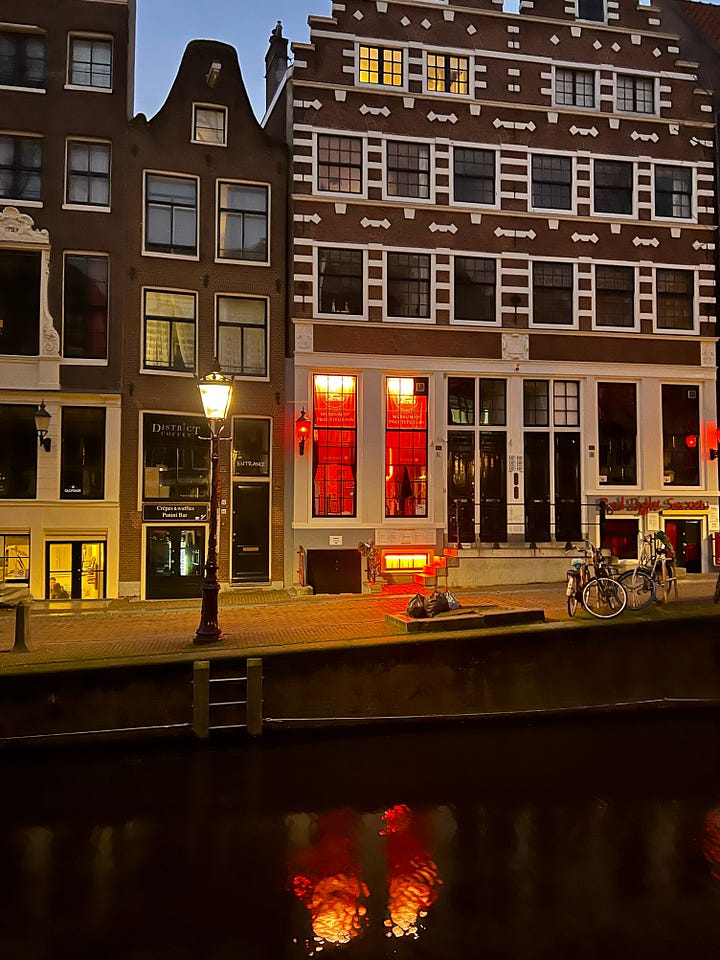
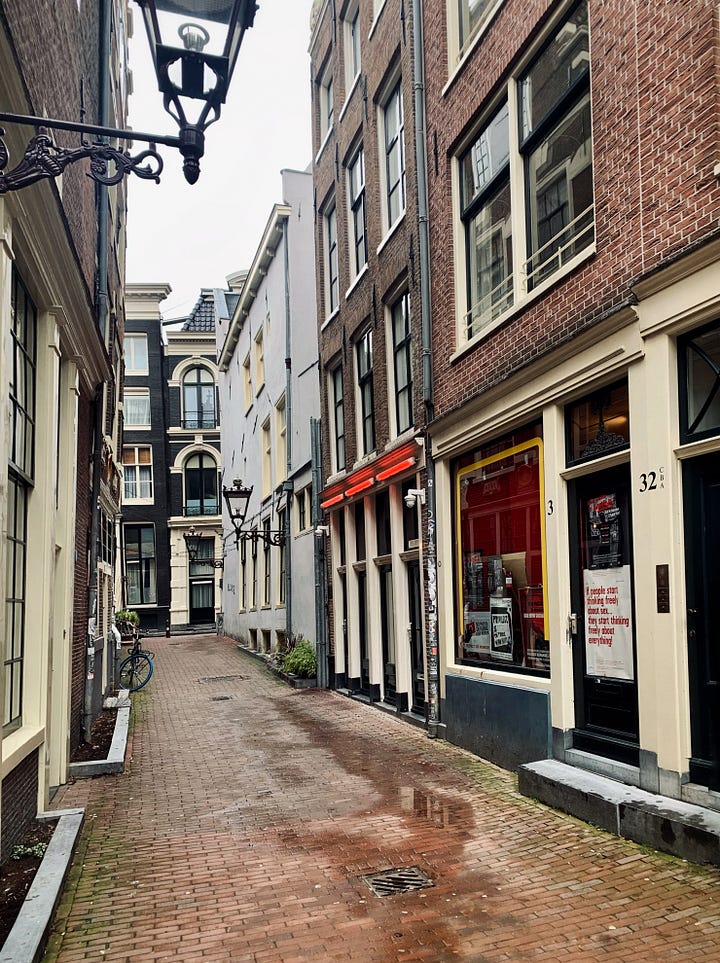

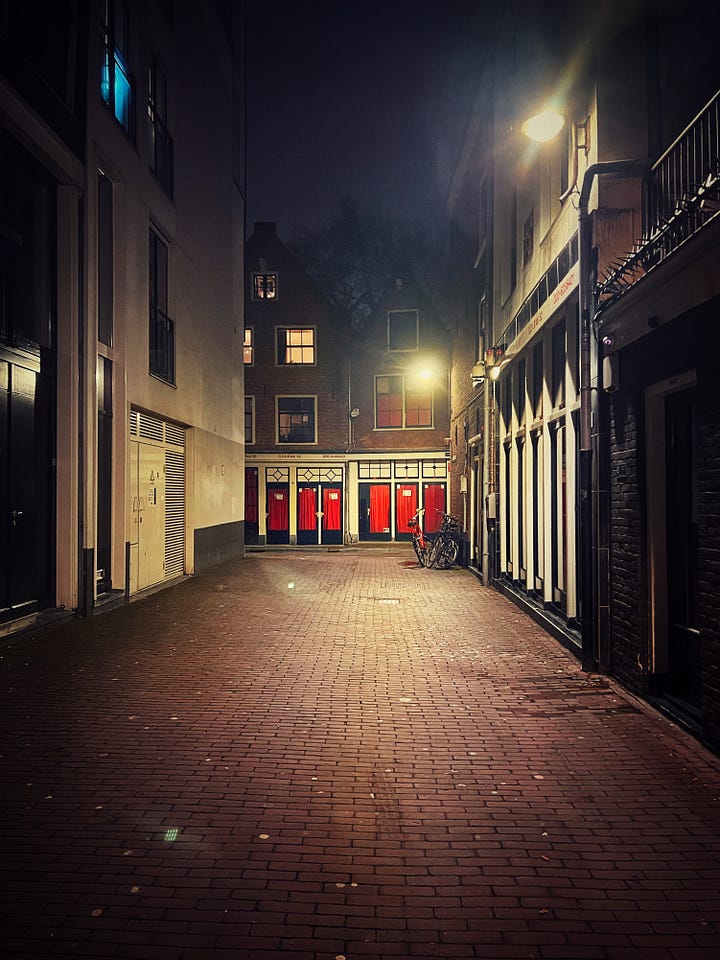
Escape the crowds:
Surprise! There is nature 🌿 in Amsterdam. And I don't mean the Vondelpark. Besides other parks like Westerpark, Flevopark, Diemerbos, Rembrandtpark and Amstelpark, you can turn to the biggest one: the Amsterdams Bos. Because it's so vast, it will never feel overcrowded. If you don't like screaming kids, you'd better avoid the goat farm.
For a more serious walk, try the first leg of the Waterkeringpad (18 km) from Amsterdam Central Station to Muiden. Check the route here.
Also worth discovering are the Dutch Water Defence Lines around Amsterdam.
Walk along the Amstel River just like Rembrandt.
Just north of Amsterdam, near Landsmeer, lies Het Twiske, a natural recreation area with plenty of opportunities for outdoor activities.
The inner harbour of the Marineterrein is a designated swimming area and popular among locals. Combine it with drinks and food at Homeland.
Geinponem (the Amsterdam dictionary)
As you might have noticed, I used some exotic words in this post. Those are typical for the city. Some Dutch people think those words, combined with the Amsterdam accent 🗣️, are annoying and affected.
Amsterdam's language is primarily Dutch, with influences from Yiddish, Bargoens, and modern street slang. This urban dialect incorporates words from Sranan Tongo (spoken in Suriname), Moroccan Arabic, and English. Some people are quick to claim that English is now the main language in Amsterdam.
Bargoens, a historical cant, has particularly shaped older generations' slang, introducing many Yiddish-origin words into Dutch. Examples like sjacheren (to trade slyly) and gabber (friend) remain part of the city's linguistic heritage. Yiddish itself - a language of Ashkenazi Jews rooted in medieval German - carries Hebrew, Aramaic, and Slavic influences, leaving a lasting mark on Amsterdam's vocabulary.
Mokum is a popular nickname for Amsterdam. It comes from the Hebrew word "makom" (מָקוֹם), which means 'place' or 'city'. In Yiddish, it was used to refer to cities (Amsterdam was Mokum Alef, and Rotterdam was Mokum Rèsj).
Damsko: a contemporary slang term for Amsterdam often used in certain street, rap, and youth subcultures.
Jajem and Pikketanussie are both slang terms used in Amsterdam to refer to jenever, the traditional Dutch gin.
Kapsones is used to describe someone who behaves arrogantly or feels superior to others. It comes from the Yiddish word "gaavsonus" (גאבזונעס) or "ga'awsonus", which in turn is derived from the Hebrew word "ga'awa" (גאווה), meaning pride or arrogance.
Geinponem is used to describe someone who is a bit of a joker. "Gein" means fun or humour, and "ponem" comes from the Yiddish word for face. It's a word we should use more often.
More words:
Googhem is a typical Amsterdam insult. It's a kind of distortion of "gek" (crazy) and is often used to describe someone as a bit odd or crazy. It's usually used in a somewhat light-hearted, not-too-offensive manner.
Gabber (or gap), pik (or pikkie): both are used as informal terms for a friend or buddy. "Gabber" comes from the Yiddish word "chaver," meaning friend or mate. "Pik" is also a word for penis, but in Amsterdam used otherwise. The most fun is to hear an old guy calling a little boy pikkie.
Pannekoek: my favourite curse word. It is not so harsh; it's kind of innocent, and it just means pancake.
Learn more about this (for my Dutch readers, I can recommend this list) and watch this vintage music video about Amsterdam slang.
Read, listen, watch & for your agenda
Enjoy 100 songs about Amsterdam (not all are in Dutch!)
See the wildlife of Amsterdam through the eyes of a cat in the documentary ‘Wild Amsterdam’.
Gosse Bouma takes beautiful photos of Amsterdam, especially at dawn. Follow him on Instagram.
For your Amsterdam 2025 agenda:
SAIL is a major ⛵️ event and one of the highlights of Amsterdam’s 750-year celebrations. Enjoy the tall ships from 20–24 August.
You'll experience Amsterdam at its absolute best during the Canal Parade on 2 August as a part of Pride 🏳️🌈.
The Amsterdam Dance Event is planned for 22-26 October
IDFA (International Documentary Festival): 12-23 November.
Uitsmijter
Talking about those aggressive cyclists. Here's an instructional video about cycling in Amsterdam. It's from 2015, so it doesn't include the horrible fat bikes we currently have.
Let's be honest. Amsterdam is a village compared to other international capitals. We can behave pretentiously, but we're still just a bunch of potato heads in an open-air museum.

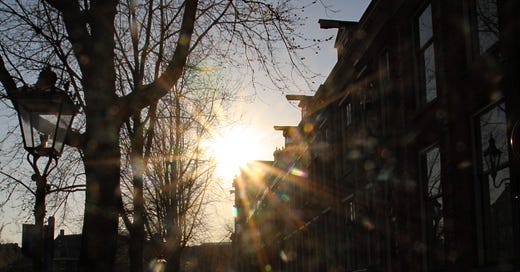






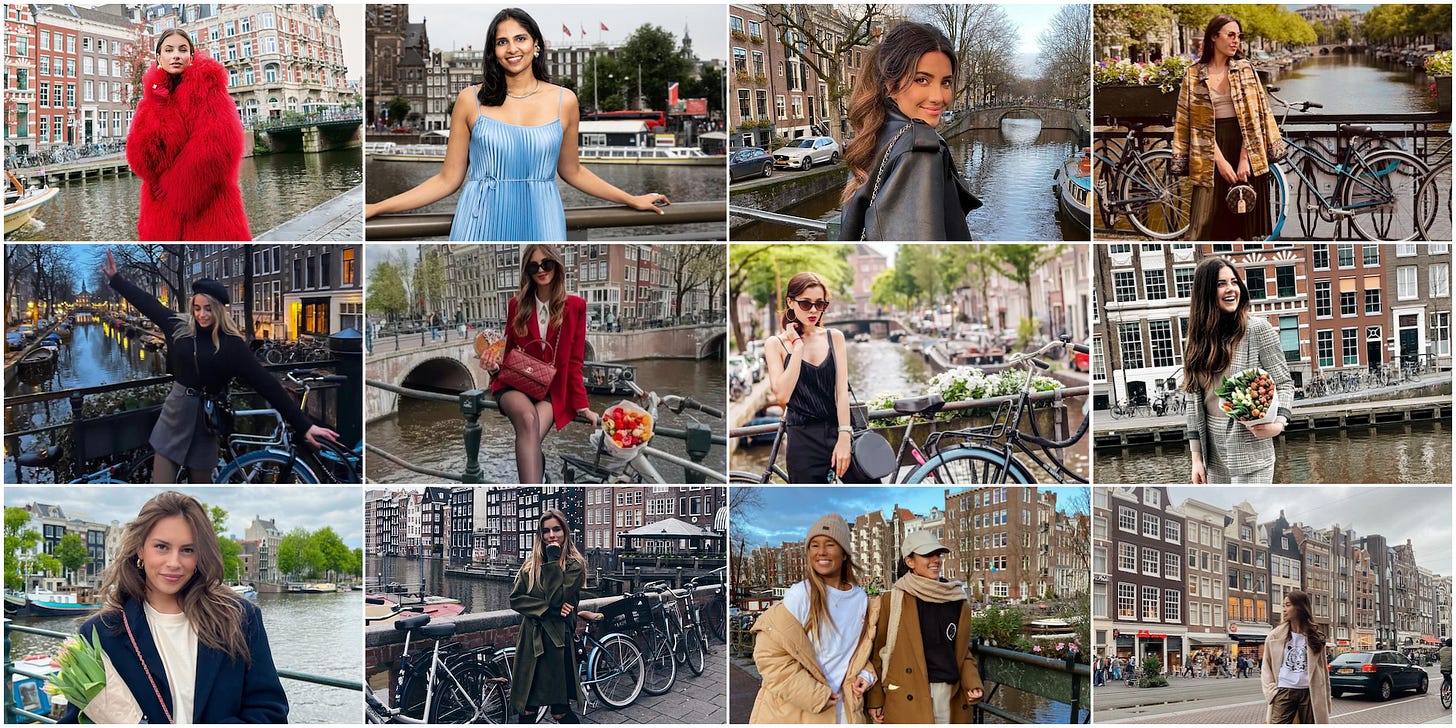
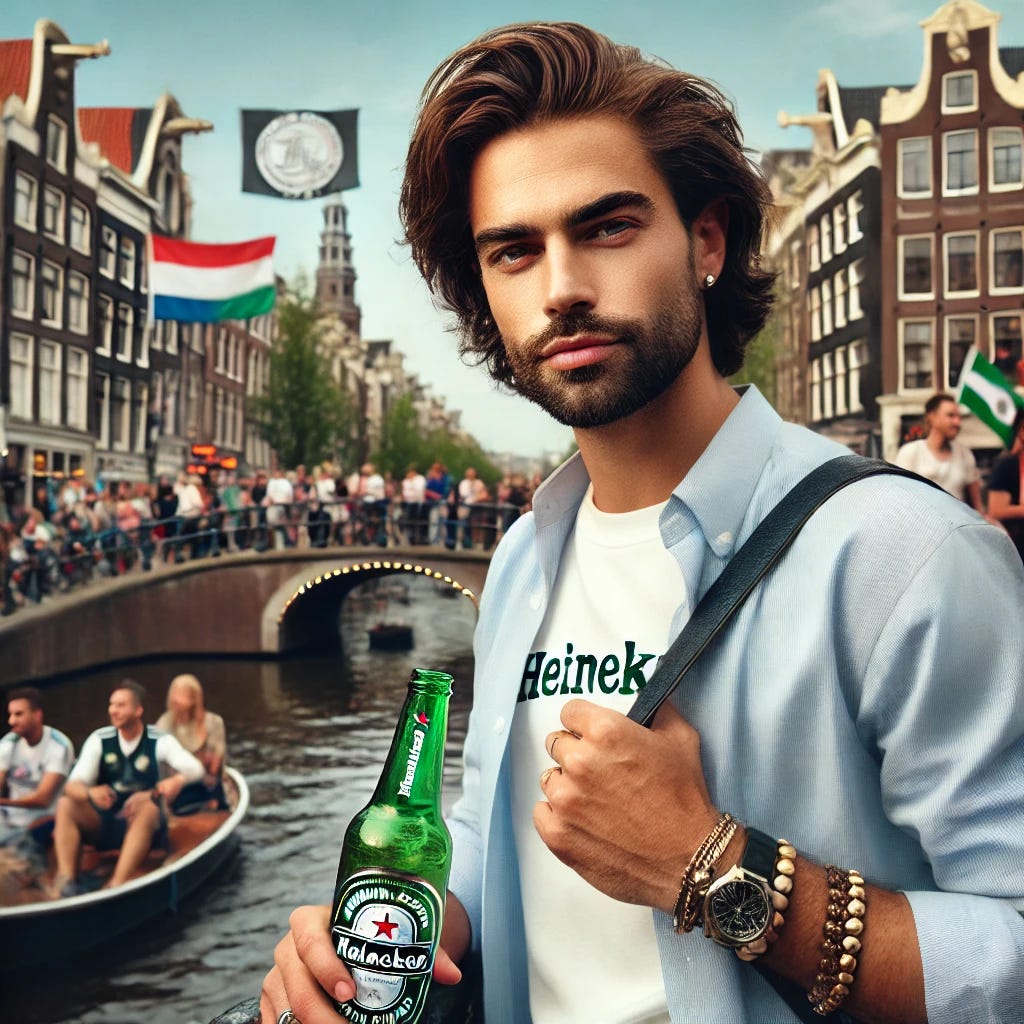
Wow, thanks for a very detailed post! I'll go back to it when I finally reach Amsterdam, probably this summer :)